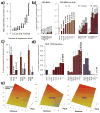A direct test of the diathesis-stress model for depression
- PMID: 28696435
- PMCID: PMC5764823
- DOI: 10.1038/mp.2017.130
A direct test of the diathesis-stress model for depression
Abstract
The diathesis-stress theory for depression states that the effects of stress on the depression risk are dependent on the diathesis or vulnerability, implying multiplicative interactive effects on the liability scale. We used polygenic risk scores for major depressive disorder (MDD) calculated from the results of the most recent analysis from the Psychiatric Genomics Consortium as a direct measure of the vulnerability for depression in a sample of 5221 individuals from 3083 families. In the same we also had measures of stressful life events and social support and a depression symptom score, as well as DSM-IV MDD diagnoses for most individuals. In order to estimate the variance in depression explained by the genetic vulnerability, the stressors and their interactions, we fitted linear mixed models controlling for relatedness for the whole sample as well as stratified by sex. We show a significant interaction of the polygenic risk scores with personal life events (0.12% of variance explained, P-value=0.0076) contributing positively to the risk of depression. Additionally, our results suggest possible differences in the aetiology of depression between women and men. In conclusion, our findings point to an extra risk for individuals with combined vulnerability and high number of reported personal life events beyond what would be expected from the additive contributions of these factors to the liability for depression, supporting the multiplicative diathesis-stress model for this disease.
Conflict of interest statement
The authors declare no conflict of interest.
Figures

References
-
- Bebbington P. Misery and beyond: the pursuit of disease theories of depression. The International journal of social psychiatry. 1987;33(1):13–20. - PubMed
-
- Beck AT. Depression: Clinical, experimental and theoretical aspects. Harper & Row; New York: 1967.
-
- McGuffin P, Katz R, Bebbington P The Camberwell Collaborative Depression Study. III. Depression and adversity in the relatives of depressed probands. The British journal of psychiatry : the journal of mental science. 1988;152:775–782. - PubMed
-
- Robins CJ, Block P. Cognitive theories of depression viewed from a diathesis-stress perspective: Evaluations of the models of Beck and of Abramson, Seligman, and Teasdale. Cognitive Therapy and Research. 1989;13:297–313.
Publication types
MeSH terms
Grants and funding
LinkOut - more resources
Full Text Sources
Other Literature Sources

